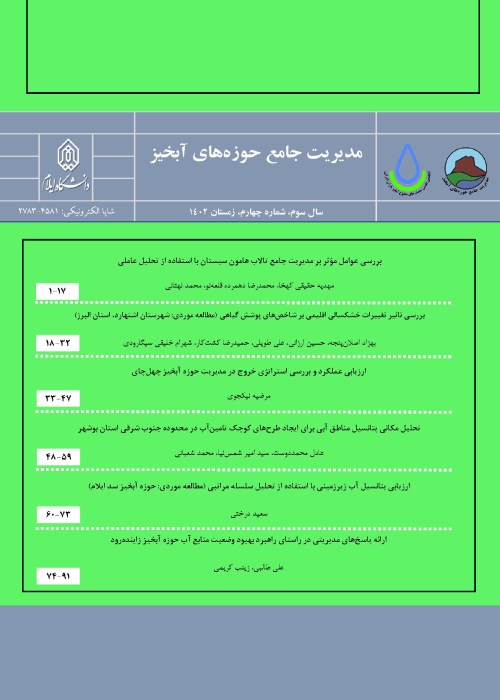Evaluation of Control Strategies for Desertification Using SWOT Model in Yazd-Ardakan Plain
Desertification is an important issue in many countries around the world, including those which are located in arid and semi-arid regions. Land degradation in arid and semi-arid regions provides the conditions for desertification due to climate change and human activities. In other words, desertification is a process which leads to the destruction of the land and its resources. Nowadays, it is necessary to know the exact criteria and indicators affecting the occurrence of desertification in order to provide a model to show the severity of degradation and determine the most important factors affecting it. Therefore, using Multi-Criteria Decision-Making (MCDM) methods and recognizing internal and external factors (strengths, weaknesses, opportunities and threats) to identify and evaluate the process of desertification and land degradation enable one to obtain the best options and plan appropriately for desertification management for its management. This study aims to provide solutions for desertification management in Yazd-Ardakan plain based on SWOT model.
The study area is Yazd-Ardakan plain, which is located in the central part of the central plateau of Iran. In this plain, due to environmental conditions, resources must be managed and used in such a way that the resources available are not destroyed. The purpose of this study is to provide desertification management solutions in Yazd-Ardakan plain based on SWOT model. For this purpose, internal and external factors affecting the desertification process in the plain were determined by Delphi method and summarized by SWOT model. Also, desertification control strategies were presented and Strengths, Weaknesses, Opportunities and Threats (SWOT) were examined. After internal and external factors were identified and the final score of these factors was obtained, using the quadratic matrix of internal and external factors, the desired solutions were selected from the proposed solutions.
The results showed that the final score of internal and external factors affecting desertification is 2.65 and 1.96, respectively. Therefore, the best strategies to control desertification in the Yazd-Ardakan plain are to deal with threats. However, due to the nature of desertification and the complexity of this phenomenon, it is important to pay attention to all solutions. In other words, using all of the solutions can guarantee the control of desertification in this region. Regarding the strengths and weaknesses of Yazd-Ardakan plain in relation to the control of desertification phenomenon, it can be said that the strengths have a relative advantage over the weaknesses, which is evidenced by the sum of internal factors (2.65). Having said that, the advantage is not great and the weaknesses of the region have a high score and show their high importance along with their strengths. The arid climate of the region and successive droughts,wind erosion centers in the region along with traditional agriculture with high water consumption and low efficiency, the concentration of environmental polluting industries and insufficient control over them have made it difficult to revive the desert despite the strengths of the region. Therefore, in order to determine desertification control strategies, it is very important to pay enough attention to the weaknesses along with the strengths. The close scoring of most of the internal factors of the region in relation to the phenomenon of desertification illustrates this well.
Regarding the opportunities and threats in Yazd-Ardakan plain in relation to the control of desertification phenomenon as well as internal factors, it can be said that the advantages of all factors are close, which shows the high importance of all factors. The difference between external and internal factors in the Yazd-Ardakan plain in relation to the phenomenon of desertification is the relative superiority of the negative points of the region over the positive points in relation to desertification, which is evidenced by the total score of external factors. In the case of external factors, as well as internal factors, social and economic issues have shown great importance.The existence of the idea of full preference of industrial and mining activities over environmental protection and the possibility of transferring labor from agriculture to industry and mining scored highest. Therefore, the strategies that can solve these problems can be considered as the most important strategies. The results of this study in choosing a solution to control and manage desertification in the Yazd-Ardakan plain, given the high importance of all internal and external factors, can guarantee desertification control in this region.
- حق عضویت دریافتی صرف حمایت از نشریات عضو و نگهداری، تکمیل و توسعه مگیران میشود.
- پرداخت حق اشتراک و دانلود مقالات اجازه بازنشر آن در سایر رسانههای چاپی و دیجیتال را به کاربر نمیدهد.



